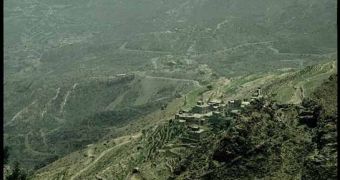In a historical aspect, the “Bible” talks about the Queen of Sheba (named Makeda in the Ethiopian tradition and Bilqis in the Islamic tradition), who traveled to Jerusalem to behold the fame of the wise King Solomon, with a very large equipage of camels carrying large amounts of spices, gold and gemstones. Many researchers believe Sheba was located where Yemen is today.
Unlike the typical image of Arabia, of sand dunes, camels and caravans, Yemen is far of being a barren land. Even if the shores of the Red Sea and Gulf of Aden are arid, the country mainly consists in mountains with a cooler temperate clime.
The moisture of the mountains is due to the trade winds coming from the Indian Ocean and bringing dew to the southern Arabian coast. In these mountains, a special bush found ideal conditions: the Arabian frankincense (Boswellia), which produces a famous resin. When burned, the frankincense spreads a sweet scent, fact that made it to be extremely solicited for religious rites. Even today, Yemenites honor their guests burning frankincense, collected especially from the Jol Plateau. The trees are notched but only a week later, a golden, sticky and scented sap seeps.
This could also have been the country of the legendary Ophir, a port or region mentioned in the Bible, famous for its wealth and for being a source of the purest gold. King Solomon is mentioned to have received a cargo of gold, silver, sandalwood, precious stones, ivory, apes and peacocks from Ophir, each three years. Anyhow, this is the place where, in ancient times, many caravans transporting gold, frankincense, myrrh, gemstones, ivory and spices had to cross in their way towards the Mediterranean coast; the local kingdoms controlled this trade, enjoying a great wealth: this was what Romans called "Arabia Felix" ("Happy Arabia").
But, when Romans adopted Christianity as the official religion, the demand for frankincense plummeted, and with this the frankincense incomes. The decline was accelerated also by the catastrophic collapse of the great dam of Marib, the most important part of a huge irrigation system that had provided water for this region since the 8th century BC.
But, the Yemen's economy was revived by the growing popularity of another trade item: coffee. By 1610, Europeans had discovered the aroma and flavor of the coffee coming from the mountains of Yemen and Ethiopia.
The city of Mocca, a port at the Red Sea located in the southernmost Yemen, turned into the main coffee exporter. This way, Mocca became a synonym to Arabian coffee for the Europeans. But soon, coffee cultivation was exported to other places, too, and Mocca's economy declined, turning the city into a quiet fishing port.
Yemen's capital, Sana, is located at 2,000 m (6,600 ft) altitude, on a plateau with temperate climate where most of the 12 million inhabitants of Yemen live (Yemen has one third of the whole population of the Arabian peninsula). Sana is thousands of years old. Yemen's architecture is characterized by stone buildings, adorned with decorative motifs and multicolor glass mosaics. The dominant color is the white of the lime (that reflects the heat). Many old buildings can have up to 8 levels and the shape of rounded towers. Because of these large buildings and the defense walls built without cement or mortar, each village looks like a giant castle built on the slope of the mountain, and fitted very well to the environment, so that you will notice them only when very close.
The mountain tribe men really look menacing. They wear fuuta, a cloth wrapping the body and resembling a skirt, with a wide girdle displaying an impressive dagger. In many villages, men also carry large machine guns on their shoulders.
The Yemenite men are proud of their weapons, and there are many street markets selling jambiyya, a large curved dagger. Generally, this is worn by over 14-year-old boys as a sign of manhood. The handle can be made of plastic, wood, or unfortunately, of the costly rhino horn, and the sheath is adorned with silver. Even if having very sharp blades, the daggers are mainly decorative.
The clime of the Yemen mountains allows the cultivation of what you would not associate with Arabia: pomegranate, peach, apricot, grapes and almonds. Wild bee honey is collected.
Most Yemenites are addicted to a drug called khat. The plant has been employed as a stimulant for centuries, in the Horn of Africa and Yemen. Its fresh leaves and tops are chewed, sucked or, less frequently, dried and consumed as tea, in order to reach a state of euphoria and stimulation, the way coca leaves are used in South America. Large mountain areas in Yemen are destined to the cultivation of khat. Men gather for hours to chat while chewing khat. Some chew it also at work or while driving.
Khat may have cultural functions, but it is also aggravating social and medical issues like anti-social behavior, unemployment, psychoses, depression, self-neglect, sleep impairment and poverty, not to mention physical health issues, such as deformed chins, appetite loss and gut diseases.
Yemen is a relatively poor country in comparison to its neighbors, yet many khat users borrow money in order to get the drug, boosting poverty levels and ruining their life quality and that of their communities. The monthly khat can mean one third of the gain of a family, as the drug is costly.

 14 DAY TRIAL //
14 DAY TRIAL //